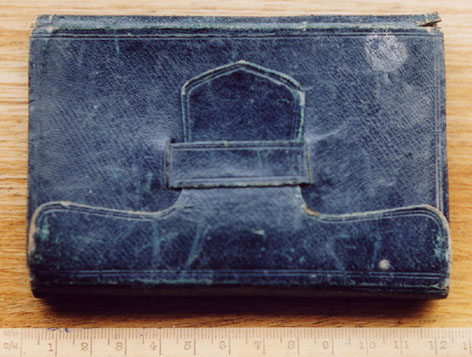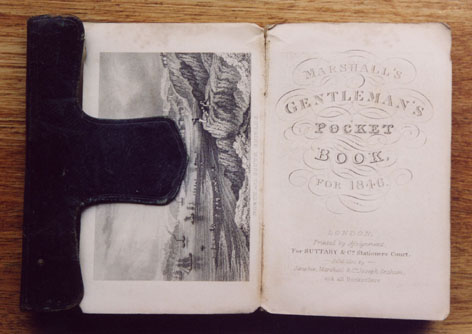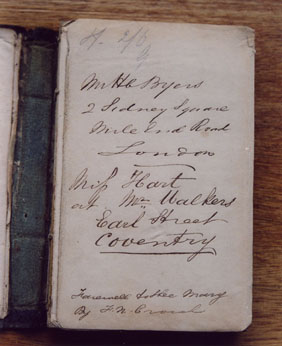Roger Donne’s Miscellany |
|
|
About This Site |
Cycling |
Family History |
Contact Me |
Site Map |
Links |
Who’s Diary? - A Genealogical Detective Story
“Gentleman’s Pocket Book for 1846”
I have in my possession a small black leather-bound pocket book, or diary, which calls itself “Gentleman’s Pocket Book for 1846”.
 |
It contains printed information which presumably would be of general use in 1846 but more interesting from my point of view, are the daily entries written in pencil by the owner in 1846. I had long assumed that it belonged to a long-dead family member since it was found in an old piece of family furniture, but tantalisingly, the owner had nowhere written down his own name. I therefore set out to try to put a name to the diarist and solve the mystery. |
 |
The first thing I did was to transcribe all the entries which the owner had made in the diary. These were the daily entries and the various notes made on the flyleaf and on the accounts pages. I have tried to transcribe exactly what was written, including the individual spellings of words. In some cases the original entries in pencil are indistinct, and sometimes I’ve had to give up and use question marks where I’m really unsure of the text. |
The diary entries are similar to my youthful diaries – lots of detail and good intentions at the beginning of the year, tailing off to nothing at all in the summer months, and returning with partial enthusiasm towards the end of the year as one realises that the initial resolution to keep a diary had faltered. I found that transcribing the entries enabled me to study each record carefully, and at length. I could later refer to my transcription without further handling of the original document, which, although quite sturdy, is showing signs wear after 150 years!
Plymouth Roots
My family come from the Westcountry – Devon and Cornwall – so I already have done some family research in this area and I have the LDS 1851 Census CD for Devon, Suffolk and Warwickshire – a wonderful bargain if you have ancestors from these counties. My father’s family came from Plymouth and Devonport in the mid 19th century, so this seemed to be a good place to start my search for the owner of the “Gentleman’s Pocket Book for 1846”. The place names referred to in the diary also are a clear indication that the owner lived and worked in Devonport.
The first thing to do was to form general impression of the condition of the author of the entries. He seemed to be a young unmarried man – lots of references to parties – “enjoyed myself much” – and girls – “met splendid girls” – and youthful indiscretions –“got drunk, could not get up over the stairs”. Most poignantly, towards the end of the diary, he records his correspondence with the mysterious Mary, maybe associating with her the popular song of the day, ‘Farewell to Thee, Mary’, which he records on the flyleaf.
He seemed to be involved in newspapers and publishing –“took cigar in the editor’s room”- and on the flyleaf note he notes the address of a supplier/ founder of Caslon typeface. And he seemed to be a professional man of some sort – the dispatch of the ‘parcel’ on the first of the month appeared to be an important event, often requiring late working, until 11 p.m on the 1st January 1846, for example.
So, who was my diarist, who was Mary, and did they ever meet again?
The Names, Places and Occupations
The obvious place to start was to try to relate the names mentioned in the diary with those of my own family or to those in the1851 census, which was sufficiently close in time to be relevant. Unfortunately, I could find no family names in the diary. However, there were some names which provided a perfect match with the 1851 census and the references in the diary, give or take the variations in spelling or the difficulties I had with reading some of the handwritten diary entries.
For example, learning French is mentioned several times in the diary – ‘the French lesson’. One of my diarist’s tutors could have been Mr Hainsellin, recorded in the 1851 census as a ‘retired language teacher’ aged 90 and living alone with one servant at 63 George Street in Devonport. Mr Hainsellin was born in France although a British subject at the time of the census. My diarist attends a party given by Mr Hainsellin on the 9 January. However, as Mr Hainsellin is retired, to continue the French lessons, apparently my diarist transfers to M. de la Rue. We can see M de la Rue in the 1851 census, where a Prosper de la Rue, living in Ker Street, Devonport records his occupation as ‘professor of languages’.
It is easy to underestimate how difficult and expensive it could be to move around and travel before the development of railways and public transport. One recorded item of my diarist’s expenditure is the payment to Mr Ellis, coachman; I presume this to be Mr John Ellis of 51 Chapel Street, Devonport, whose occupation in the 1851 census is ‘hackney coach master’.
Entertainment
Social entertainment seemed to involve much visiting and calling. Balls and parties seemed to feature quite prominently in the daily round. I have not been able to match up the names mentioned with any certainty in the majority of cases. However, it’s likely that the ‘party at M. Richards, draper, refers to Michael Richards, listed as a mercer and tailor in the 1851 census, at 22 and 23 Fore Street, Devonport.
When not entertained at parties, dining out seemed a favourite occupation. The Royal Hotel at 83 Fore Street, Devonport is often mentioned, under that name or referred to as Moorshead’s, since it was under the proprietorship of the innkeeper, Robert Moorshead. Other eating establishments which get a mention are the Commercial Hotel, in Old Town Street, Plymouth, and P.E Rowes’.
Visits to the theatre are mentioned on several occasions, both at Devonport and Plymouth. The Plymouth Theatre of this date was a grand affair, opened on 23 August 1813. It seated 1,200 and survived until 1937 when it was demolished to make way for a cinema. My diarist records going to see ‘Ellen Faucett’ as Juliet and he was also pleased with ‘the Hunchback’. I can find no theatre records of the time which allow me to match up these theatre productions with the dates in the diary, although playbills from other parts of the Westcountry indicate that ”The Hunchback” by James Sheridan Knowles, (1784-1862) was a popular play of the time .
Also worth mentioning is the Devonport Mechanics' Institute, which my diarist mentions in his entry for 14 January. White's Devonshire Directory of 1850 records that this was established in 1825 and in 1843 was so successful that it erected a handsome building in Duke Street. By 1850 a second building had been erected comprising a lecture hall holding 1000 persons; a large subscription news room, a number of class rooms, a museum, and a library of more than 3000 volumes. The institution presented weekly lectures during eight months of the year, and various evening classes.
Sentimental Songs and Sweethearts
 I was struck by the entries which record the writing and receipt of letters
to ‘Mary’, with the first letter sent at the beginning of October. Clearly, Mary was very important to my young diarist, although there is no record of their first meeting
– possibly she was a summer visitor to Plymouth? And if she was a sweetheart, did it all come to nought, with my diarist taking solace from the sentimental song, ‘Farewell
to thee, Mary’. I have not been able to trace the song, but the composer, Frederick Nichols Crouch is well known for the hugely successful ‘Kathleen Mavourneen’,
popular during the American Civil War.
I was struck by the entries which record the writing and receipt of letters
to ‘Mary’, with the first letter sent at the beginning of October. Clearly, Mary was very important to my young diarist, although there is no record of their first meeting
– possibly she was a summer visitor to Plymouth? And if she was a sweetheart, did it all come to nought, with my diarist taking solace from the sentimental song, ‘Farewell
to thee, Mary’. I have not been able to trace the song, but the composer, Frederick Nichols Crouch is well known for the hugely successful ‘Kathleen Mavourneen’,
popular during the American Civil War.
One unexplained address noted in the diary is ‘Miss Hart at Mr Walkers, Earl Street, Coventry’. Could this be Mary?
Breakthrough and Resolution of the Mystery
My first breakthrough came in the course of my systematic attempts to match up the names in the diary with those in the 1851 Census CD for Devon, Warwickshire and Suffolk. Although there was no apparent connection with the area, I tried searching for the name Byers. This appears in the diary as an address written on the front flyleaf, for Mr H G Byers of Mile End Road, London.
Immediately I found a listing for William Gilborn Byers (58) living at 116 Fore Street, whose occupation of “newspaper proprietor and town councillor” fitted very well with the image of a businessman associated with publishing that I had conjured up for my diarist. There was a small snag however. William Byers was 58 in 1851, and was living with his wife, Eliza Coppin Byers. I was sure that my diarist had to be a much younger man, and unmarried. Perhaps William Byers was the ‘father’ referred to in the diary on 3 April and 5 March?
Further information on William Byers came to light in the 1844 Pigot’s Directory for Plymouth. William Byers, of 32 Fore Street, Devonport, is listed as ‘proprietor of the Devonport Independent and Plymouth and Stonehouse Gazette'. Furthermore, there is a business listing for ‘Byers and Son’ at 32 Fore Street, Devonport, who announce themselves grandly to be ‘booksellers, stationers and printers to his late Majesty and publishers of the 'Plymouth and Devonport Guide'.
At this stage, chance took a turn. My 1851 Census CD includes Warwickshire as one of the listed counties. I had no family connection with Warwickshire, so it seemed of little relevance to my search. However, in 1851, a Byers family was listed in Hertford Terrace, Coventry. These were Frederick C. Byers, his wife Mary, and two children, Francis and Mary. Furthermore, Frederick’s occupation was ‘accountant in the ribbon trade’, and his age was 27 at the time. This accorded very well with the image of the young professional man who owned the diary, since he would have been just 22 in 1846. And had I discovered the mysterious Mary of the diary? – she was 21 in 1851, and would have been just 16 or 17 in 1846. I felt sure I was on the right track, and further confirmation was provided by the place of birth of Frederick, in Stoke Damerel in Devonport.
I then turned to that immensely useful family history resource on the Internet, the LDS family search website featuring a transcription from their International Genealogical Index. I searched for Frederick Byers and immediately struck gold, by finding the marriage of Frederick Coppin Byers to Mary Jane Hart, at St Michaels, Coventry, in March 1847, listing the groom's father as William Gisborn (sic) Byers, and the bride's father as Francis Hart. This was later confirmed by the brief report of the marriage found in 'Jackson's Oxford Journal' of Saturday, 20 March 1847 which states "At Coventry, Mr Frederick Byers of Devonport, to Mary, only dau. of Frans. Hart Esq. of Stivichall Villa, Warwickshire".
So everything ties neatly. I can link Frederick to the Byers family of Devonport through his mother’s family name of Coppin, which he apparently received as his middle name. He managed to marry Mary Hart – surely the Miss Hart of the diary, and the recipient of Frederick’s letters which he records sending. Marriage followed closely on first acquaintance – one wonders whether this whirlwind romance of the young couple met with the entire approval of their families. Certainly Frederick found employment in Warwickshire, well away from his family home and father’s business. But that sort of secret is not to be disclosed by ‘The Gentleman’s Pocketbook’!
Postcript
A search of transcriptions of the General Record Office index of Births, Marriages and Deaths reveals the following entries for deaths in the March quarter of 1854:
- Frederick Coppin Byers, death registered in the Westminster Registration District, confirmed by a death announcement in the 'Morning Chronicle' of Friday 24 February 1854 which states "On 19th inst., at Brompton, Mr Frederick C. Byers of Coventry and formerly of Devonport, aged 32."
- William Gilborn Byers, death registered in the Stoke Damerel Registration District
Go to Top
©Roger Donne 2003-2008
Updated 18 April 2008